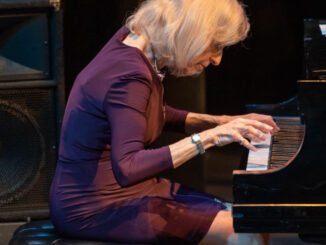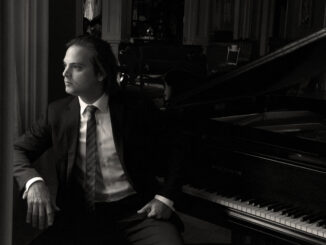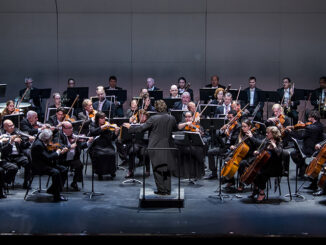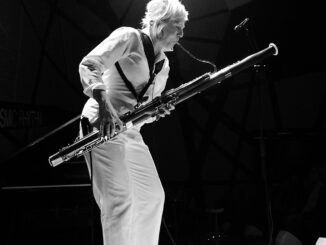
Elaine Rinaldi conducted Orchestra Miami in Marvin David Levy’s “Atonement” Sunday at Temple Israel of Greater Miami.
Orchestra Miami marked Holocaust Remembrance Day with a performance of Marvin David Levy’s moving oratorio, Atonement. The concert took place Sunday afternoon at Miami’s historic Temple Israel as part of the ensemble’s “Discover Miami Through Music” series, which features concerts at landmark venues.
The program opened, oddly, with Leonard Bernstein’s Overture to Candide. While the sanctuary’s reverberant acoustic posed balancing problems, artistic director Elaine Rinaldi drew resonant string tone and strength from the brass in a relaxed traversal of this popular work.
Atonement is a conflation of three works by Levy with a connecting narration. The work is scored for sizable orchestral forces, chorus and soprano and tenor soloists. The score proved the most ambitious offering to date by Rinaldi and, for the most part, she met the oratorio’s challenges impressively.
Rabbi M. Thomas Heyn of Temple Israel eloquently read the narratives introducing the “Inquisition” and “Masada” sections. The “Holocaust” section opens with the recorded sound of Adolf Hitler’s voice with a crowd yelling “Sieg heil!” followed by the sound of gun shots and sirens. A woman’s voice intones “Our end is near, our days are done,” followed by “O Star of David,” an excerpt from Levy’s still-unproduced children’s opera The Zachary Star. This brief setting for chorus and organ focuses not on tragedy but on hope. Bringing fervor to Levy’s austere chorale, the 14- voice choir produced a corporate sonority that sounded nearly triple its size in the resonant acoustic.
“Canto de los Marranos” (Song of the Secret Jews), a cantata for soprano and orchestra, forms the score’s central section devoted to the Inquisition. The marranos were Spanish Jews who had renounced their faith and embraced Catholicism under force of the Inquisition but continued to practice Judaism in private, particularly in Sephardic areas. The narrator reads Queen Isabella’s chilling 1492 proclamation that marranos must leave Spain “under penalty of death,” the words punctuated by soft timpani rumbles.
The score is partially a solo setting of excerpts from the Latin mass but the orchestral and vocal lines are agitated and fiercely dissonant, reflecting the speaker’s pain. There are segments in Spanish, Ladino and Hebrew that reflect the speaker’s true inner thoughts. The vocal lines turn dark and agonized with wild leaps between the upper and lower registers, often accompanied by astringent strings. The click of castanets against harp and plucked strings hint at Ladino folk song and a febrile clarinet riff suggests klezmer. In the final section, gutsy incantation leads to bristling orchestral patterns with the final ‘Amen’ calming the instrumental waters.
The cantata is a beautifully conceived vocal gem and a formidable challenge for the singer. Levy fused the disparate elements of folk music, modernism and operatic arioso with consummate skill.
Elizabeth Caballero proved a terrific soloist. She managed the high tessitura adroitly. Her top notes were clear and ringing while the gutsy sound of Caballero’s lower register had mezzo-like depth. Caballero’s dramatic projection and impassioned delivery of recitative-like moments were riveting. Rinaldi brought clarity to the instrumental textures, giving equal weight to the acerbic and songful elements.
Two sections from “Masada,” Levy’s large-scale 1973 oratorio, conclude Atonement. Masada was the mountaintop fortress where, after the fall of Jerusalem, 960 men, women and children held attacking Roman forces at bay for three years. When it became obvious that the Romans would finally penetrate the mountain, the inhabitants decided to commit mass ritual suicide, leaving the Romans a hollow victory. The first part describes the journey to Masada with a solo tenor playing the group’s leader Elazar ben Ya’ir. Initial march like strains in winds and percussion morph into dramatic, animated choral writing in a kind of Judaic Carmina Burana.
The final part opens with strains of sadness in the strings as the choir tells of the thousand of Roman soldiers surrounding the mountain. In the tenor’s solo narrative description of branches wilting on the trees, Levy’s brand of dark lyricism comes to the fore. Elazar’s final speech, in which he beseeches his people to take their own lives rather than submit to slavery or death by their conquerors, begins in soft tones and rises to declamatory force. High harmonic flights in the female voices highlight a prayer of farewell. The final churning choral and orchestral proclamation heralds both tragedy and triumph.
The “Masada” sections are powerful and ringing in sheer sonic velocity. Rinaldi led her forces with skill and fine attention to changing tempo and gradations of volume. The hard-working choir was musically accurate and strong and instrumental volleys really registered.
Michael Hendrick voiced Elazar’s declamation in heldentenor tones. His baritonal bottom was particularly effective and the edge in his top tones was not inappropriate to the text. While Hendrick’s English diction was clear, in the final speech he ran into serious vocal problems. The tenor visibly struggled with breath support for the long cantorial lines and his voice cracked on extended high notes.
Still, even with the fitful technical lapses, kudos to Rinaldi for presenting this important score in a strongly prepared, well-drilled performance. It was a fitting memorial to a significant American composer with a distinctive voice.
Posted in Performances
Leave a Comment







Be the first to comment